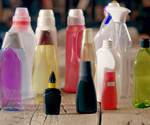Thermoformed Detergent Tub Now Contains 50% Recycled PP
Tub sits inside a recycled cardboard wrapper that permits a 40% reduction in the overall weight of plastic.
In the U.S., recycling of post-consumer PP has lagged far behind that of HDPE. Figures from the American Chemistry Council and Association of Plastic Recyclers total less than 515 million lb of PP in bottles and non-bottle rigid plastics in 2017, vs. almost 1.5 billion lb for HDPE. As I wrote recently, this is disappointing when you consider how versatile and widely used PP is, and the fact of periodic supply tightness and resulting volatile prices, both of which could be moderated by a more robust PP recycling stream.

In Europe, where the recycling rate for plastics packaging is more than three times that in the U.S., an inspirational example of post-consumer PP recycling is Henkel’s Persil laundry-detergent package. Made by Greiner Packaging in Austria, utilizing its K3 technology, the Persil package consists of a thermoformed PP tub containing 50% post-consumer recycle (PCR) inside a cardboard wrapper with 92% recycled content.
Greiner’s long-established K3 technology utilizes the cardboard sleeve to lightweight the plastic component (which can be either thermoformed or injection molded) by more than 40%. A patented tear-off system enables easy and complete separation of the two components for separate disposal.
In this case, the PP tub is thermoformed from two-layer sheet, so that the inside of the tub is white virgin resin and the outside is gray PCR, which is covered by the printed cardboard wrapper. Henkel, which has strong brands in laundry, home care, and beauty care, recently strengthened its commitment to the circular economy by stating plans to cut in half its use of virgin plastics from fossil sources by 2025.
Related Content
-
Process Monitoring or Production Monitoring—Why Not Both?
Molders looking to both monitor an injection molding process effectively and manage production can definitely do both with tools available today, but the question is how best to tackle these twin challenges.
-
Is There a More Accurate Means to Calculate Tonnage?
Molders have long used the projected area of the parts and runner to guesstimate how much tonnage is required to mold a part without flash, but there’s a more precise methodology.
-
Got Streaks or Black Specs? Here’s How to Find and Fix Them
Determining the source of streaking or contamination in your molded parts is a critical step in perfecting your purging procedures ultimately saving you time and money.
















